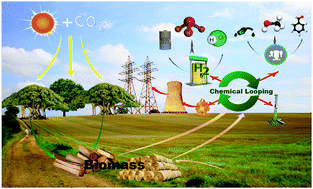当前位置:
X-MOL 学术
›
Energy Environ. Sci.
›
论文详情
Our official English website, www.x-mol.net, welcomes your
feedback! (Note: you will need to create a separate account there.)
Biomass-based chemical looping technologies: the good, the bad and the future
Energy & Environmental Science ( IF 32.4 ) Pub Date : 2017-05-19 00:00:00 , DOI: 10.1039/c6ee03718f Xiao Zhao 1, 2, 3, 4, 5 , Hui Zhou 6, 7, 8, 9, 10 , Vineet Singh Sikarwar 1, 2, 3, 4, 5 , Ming Zhao 1, 2, 3, 4, 5 , Ah-Hyung A. Park 6, 7, 8, 9, 10 , Paul S. Fennell 6, 11, 12, 13 , Laihong Shen 4, 14, 15, 16, 17 , Liang-Shih Fan 9, 18, 19, 20
Energy & Environmental Science ( IF 32.4 ) Pub Date : 2017-05-19 00:00:00 , DOI: 10.1039/c6ee03718f Xiao Zhao 1, 2, 3, 4, 5 , Hui Zhou 6, 7, 8, 9, 10 , Vineet Singh Sikarwar 1, 2, 3, 4, 5 , Ming Zhao 1, 2, 3, 4, 5 , Ah-Hyung A. Park 6, 7, 8, 9, 10 , Paul S. Fennell 6, 11, 12, 13 , Laihong Shen 4, 14, 15, 16, 17 , Liang-Shih Fan 9, 18, 19, 20
Affiliation

|
Biomass is a promising renewable energy resource despite its low energy density, high moisture content and complex ash components. The use of biomass in energy production is considered to be approximately carbon neutral, and if it is combined with carbon capture technology, the overall energy conversion may even be negative in terms of net CO2 emission, which is known as BECCS (bioenergy with carbon capture and storage). The initial development of BECCS technologies often proposes the installation of a CO2 capture unit downstream of the conventional thermochemical conversion processes, which comprise combustion, pyrolysis or gasification. Although these approaches would benefit from the adaptation of already well developed energy conversion processes and CO2 capture technologies, they are limited in terms of materials and energy integration as well as systems engineering, which could lead to truly disruptive technologies for BECCS. Recently, a new generation of transformative energy conversion technologies including chemical looping have been developed. In particular, chemical looping employs solid looping materials and it uniquely allows inherent capture of CO2 during the conversion of fuels. In this review, the benefits, challenges, and prospects of biomass-based chemical looping technologies in various configurations have been discussed in-depth to provide important insight into the development of innovative BECCS technologies based on chemical looping.
中文翻译:

基于生物质的化学循环技术:好的,坏的和未来
尽管生物质能源密度低,水分含量高且灰分成分复杂,但它是一种有前途的可再生能源。生物质在能源生产中的使用被认为是近似碳中性的,如果将其与碳捕获技术结合使用,则总的能量转化甚至可能对净CO 2排放量产生负面影响,这被称为BECCS(含碳的生物能源)。捕获和存储)。BECCS技术的最初发展通常是建议在传统的热化学转化过程(包括燃烧,热解或气化)的下游安装一个CO 2捕集单元。尽管这些方法将从已经完善的能量转换过程和CO 2的适应中受益捕获技术,它们在材料和能量集成以及系统工程方面受到限制,这可能会导致BECCS真正具有破坏性的技术。近来,已经开发了包括化学环化在内的新一代的转化能量转换技术。特别地,化学回路采用固体回路材料,并且其独特地允许在燃料转换期间固有地捕获CO 2。在这篇综述中,已经深入讨论了各种配置中基于生物质的化学环技术的好处,挑战和前景,从而为基于化学环的创新BECCS技术的发展提供了重要的见识。
更新日期:2017-09-13
中文翻译:

基于生物质的化学循环技术:好的,坏的和未来
尽管生物质能源密度低,水分含量高且灰分成分复杂,但它是一种有前途的可再生能源。生物质在能源生产中的使用被认为是近似碳中性的,如果将其与碳捕获技术结合使用,则总的能量转化甚至可能对净CO 2排放量产生负面影响,这被称为BECCS(含碳的生物能源)。捕获和存储)。BECCS技术的最初发展通常是建议在传统的热化学转化过程(包括燃烧,热解或气化)的下游安装一个CO 2捕集单元。尽管这些方法将从已经完善的能量转换过程和CO 2的适应中受益捕获技术,它们在材料和能量集成以及系统工程方面受到限制,这可能会导致BECCS真正具有破坏性的技术。近来,已经开发了包括化学环化在内的新一代的转化能量转换技术。特别地,化学回路采用固体回路材料,并且其独特地允许在燃料转换期间固有地捕获CO 2。在这篇综述中,已经深入讨论了各种配置中基于生物质的化学环技术的好处,挑战和前景,从而为基于化学环的创新BECCS技术的发展提供了重要的见识。











































 京公网安备 11010802027423号
京公网安备 11010802027423号